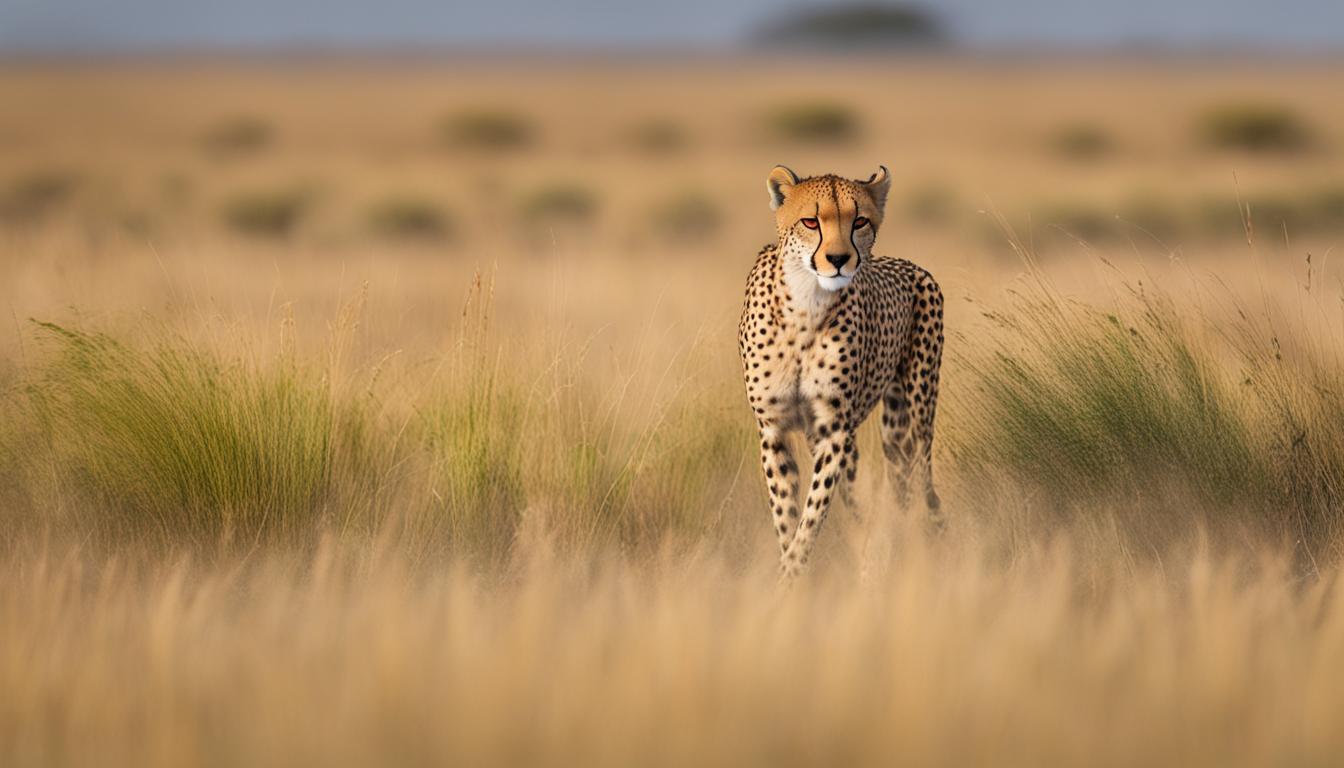Cheetahs are fascinating animals known for their incredible speed and agility. But have you ever wondered what cheetahs eat and how they hunt? In this article, we will explore the cheetah’s diet, food habits, prey preferences, hunting techniques, and their unique dietary adaptations in the wild.
Understanding the cheetah’s diet is crucial to appreciating their remarkable evolutionary adaptations. Cheetahs are carnivores and primarily feed on small antelope like springbok, impala, and gazelles. They are skilled hunters that rely on their exceptional speed and camouflaging abilities to stalk and capture their prey.
When it comes to hunting, cheetahs employ a remarkable strategy. They patiently observe their target, stealthily inching closer with every move. Once the perfect moment arrives, they burst into action, sprinting at incredible speeds of up to 60 miles per hour. This burst of speed allows them to close the gap between themselves and their prey within seconds.
Once a cheetah catches its prey, it quickly clamps down on the prey’s windpipe, suffocating it. This efficient technique ensures that their meal is secure and ready for consumption.
Cheetahs’ dietary needs are also influenced by their unique adaptations. Their streamlined body and lightweight bones contribute to their exceptional speed, making them one of the fastest land animals on the planet. Additionally, cheetahs have specialized paw pads and semi-retractable claws that provide traction while running, enabling precise maneuvers during hunts.
Now that you have a glimpse into the cheetah’s diet, food habits, prey preferences, hunting techniques, and unique adaptations, you can appreciate these magnificent creatures even more. Stay tuned for the upcoming sections where we delve deeper into cheetahs’ dietary adaptations, preferred prey, drinking habits, and their diet in different habitats and zoos.
Cheetahs’ Dietary Adaptations for Speed and Hunting
Cheetahs are renowned for their incredible speed and agility, which are essential for their hunting success. These majestic big cats have a range of adaptations that enable them to excel in the pursuit and capture of their prey.
One of the primary adaptations of cheetahs is their specialized musculoskeletal system. Their bodies are built for speed and agility, with a streamlined form and light bones. This physical composition minimizes drag and allows them to reach impressive speeds of up to 70 miles per hour in short bursts. Additionally, cheetahs have long and slender limbs, which help to maximize their stride length and acceleration during chases.
Another crucial adaptation for hunting is found in their paws. Cheetahs have unique paw pads and semi-retractable claws, which provide them with excellent traction while running. This enables them to maintain control and grip the ground firmly, allowing for quick changes in direction during high-speed pursuits. Their claws also act as cleats, providing stability and minimizing slippage on different types of terrain.
Another notable adaptation of cheetahs is their respiratory system. To support their need for oxygen during intense sprints, cheetahs have enlarged nostrils and lungs, allowing for rapid inhalation and effective oxygen intake. This enhances their overall endurance and performance during high-speed pursuits, ensuring that they can maintain their speed for longer distances.
Cheetahs’ Hunting Behavior
In addition to their physical adaptations, cheetahs possess remarkable hunting behavior that aids in their successful hunts. Cheetahs are stealthy predators, relying on their exceptional eyesight and camouflage to stalk their prey undetected. They closely observe their surroundings, patiently waiting for the perfect moment to strike.
Once they spot a suitable target, cheetahs employ their impressive burst of speed to chase down their prey. They can accelerate from 0 to 60 miles per hour in just a few seconds, quickly overtaking their quarry. During the chase, cheetahs utilize their long tail as a rudder, enabling them to make rapid turns and sudden changes in direction without losing momentum.
Once within striking distance, cheetahs employ a unique hunting technique. Unlike other big cats that employ a suffocation bite to the throat, cheetahs typically aim for the prey’s snout. By clamping down on the snout, they obstruct the breathing passages and cause suffocation, ensuring a quick and efficient kill.
Overall, the combination of their physical adaptations and hunting behavior makes cheetahs one of nature’s most formidable predators. By harnessing their speed, agility, and specialized techniques, they are optimized for hunting success in their natural habitat.
Cheetahs’ Preferred Prey in the Wild
Cheetahs are renowned for their speed and agility, which allows them to successfully capture their preferred prey in the wild. These sleek felines primarily target medium-sized ungulates, such as gazelles, impalas, and other small- to medium-sized antelopes. Their hunting habits are honed to perfection, as they prefer to focus on younger animals for easier takedowns.
By targeting medium-sized ungulates, cheetahs ensure that their hunting efforts are not in vain. These prey species provide a sufficient amount of meat to sustain the cheetah’s dietary needs. Additionally, hunting smaller animals may require more energy expenditure compared to the reward gained, making medium-sized ungulates an optimal choice for the cheetah’s survival in the wild.
Although cheetahs primarily rely on ungulates as their main source of food, they also occasionally hunt smaller mammals, birds, and game birds. These additional prey items serve as alternative sources of nutrition when their usual prey is scarce or unavailable. It showcases the cheetah’s adaptability and resourcefulness in maintaining their dietary requirements in various environments.
| Prey | Frequency of Hunting |
|---|---|
| Gazelles | High |
| Impalas | High |
| Other Small- to Medium-Sized Antelopes | High |
| Small Mammals | Occasional |
| Birds and Game Birds | Occasional |
“Cheetahs are highly specialized hunters, targeting medium-sized ungulates with precision and efficiency.” – Dr. Jane Wilson, Wildlife Biologist
The successful hunting strategies employed by cheetahs ensure their survival in the wild. By focusing on their preferred prey, these magnificent predators have adapted to their environment, utilizing their speed and agility to secure their next meal. Understanding the cheetah’s dietary preferences and hunting habits provides valuable insights into their role as efficient predators in the animal kingdom.
Cheetahs’ drinking habits

Cheetahs have unique drinking habits that are essential for their survival in their natural habitats. While they do require water to quench their thirst, they have adapted to survive for extended periods without it due to the scarcity of water sources in their environments. Understanding the cheetah’s water intake and drinking habits provides valuable insights into their ability to thrive under challenging conditions.
In the wild, cheetahs primarily obtain water from rivers and water holes. They typically drink water once every 3 to 4 days, conserving their energy and minimizing their need for hydration. This adaptation allows them to endure long periods without access to water, making them highly resilient in arid regions.
It is fascinating to observe how cheetahs have evolved to survive without frequent water intake. This adaptation is crucial for their survival as they inhabit regions where water scarcity is a constant challenge. By decreasing their water requirements, cheetahs can focus their energy on hunting and other essential activities, maximizing their chances of successful prey capture.
“Cheetahs have impressively adapted to their environment, including their water intake. They can go for days without drinking water, a remarkable feat that enables them to thrive in their arid habitats,” says Dr. Sarah Thompson, a wildlife biologist specialized in carnivore species.
Table: Cheetahs’ Water Intake and Survival in Different Environments
| Habitat | Water Source | Drinking Frequency |
|---|---|---|
| Kalahari Desert | Rivers, Water Holes | Once every 3-4 days |
| Serengeti National Park | Rivers, Water Holes | Once every 3-4 days |
| Kruger National Park | Rivers, Water Holes | Once every 3-4 days |
This table highlights the cheetah’s ability to survive in different habitats with limited water availability. Whether in the Kalahari Desert, Serengeti National Park, or Kruger National Park, cheetahs exhibit consistent behavior in terms of their drinking frequency and reliance on rivers and water holes as their water sources. This demonstrates their remarkable adaptability and efficient water utilization.
Overall, understanding cheetahs’ drinking habits and their ability to survive without frequent water intake allows us to appreciate the remarkable adaptations that enable these magnificent creatures to thrive in their challenging environments.
Cheetahs’ Diet in Different Habitats and Zoos
When it comes to their diet, cheetahs show some variations depending on their habitat. In Africa, where they roam the vast savannahs, cheetahs primarily hunt species such as gazelles, impalas, and wildebeest. These medium-sized ungulates provide the necessary nutrition to sustain the cheetah’s energy-intensive lifestyle. In Asia, where cheetahs are now mostly extinct in the wild, their preferred prey includes goitered gazelles and wild sheep.
In zoos, cheetahs have a carefully curated diet to meet their nutritional requirements. They are usually fed a mix of horse meat, beef, chicken, and high-quality meat-based feed specifically formulated for their dietary needs. Zoos closely monitor the cheetahs’ diet to ensure they receive all the necessary nutrients for their health and well-being. This controlled diet in captivity aims to mimic the cheetahs’ natural prey and provide them with a balanced and nutritionally rich diet.
To showcase the differences in cheetahs’ diet in different habitats and zoos, here’s a comparative table:
| Habitat | Prey Animals | Zoo Diet |
|---|---|---|
| Africa | Gazelles, Impalas, Wildebeest | Horse meat, Beef, Chicken, Meat-based feed |
| Asia | Goitered Gazelles, Wild Sheep | Horse meat, Beef, Chicken, Meat-based feed |
It’s important to note that while cheetahs in zoos may have a consistent diet, their wild counterparts have to adapt to the availability of prey in their specific habitats. This variation in diet highlights the cheetah’s ability to thrive and survive in different environmental conditions.
Habitat-specific cheetah diets and hunting strategies
Cheetahs have adapted their diet and hunting strategies to their specific habitats, allowing them to thrive in different environments. In the Kalahari region, cheetahs primarily hunt the springbok as their preferred prey. The springbok’s smaller size and agility make it an ideal target for the cheetah’s speed and hunting techniques. Cheetahs in the Serengeti National Park focus on Thomson’s gazelles, taking advantage of the vast grasslands and open spaces to build up speed and execute their hunting maneuvers.
In Kruger National Park, cheetahs target impalas and reedbuck due to the prevalence of these species in the area. The landscape and vegetation provide hiding spots for cheetahs to stalk their prey, utilizing their excellent camouflage. These adaptations allow cheetahs to blend seamlessly into their surroundings and surprise their unsuspecting prey.
To effectively hunt in their respective habitats, cheetahs employ different hunting strategies. In the open plains of the Kalahari and Serengeti, cheetahs rely on their incredible speed to chase down their prey. With explosive acceleration and a top speed of up to 70 miles per hour, cheetahs can quickly close the distance between them and their target before launching a sprint to catch their prey. In contrast, in Kruger National Park’s more wooded areas, cheetahs use stealth and patience to stalk their prey. They carefully move through the terrain, utilizing cover and shadows to get within striking distance.
Understanding the diverse diet and hunting strategies of cheetahs in different habitats provides valuable insights into their adaptability and survival skills. These remarkable big cats have evolved to make the most of their surroundings, showcasing their ability to thrive in a range of environments.
“Cheetahs have honed their hunting techniques to match the specific characteristics of their habitat, whether it be the wide-open plains of the Serengeti or the dense vegetation of Kruger National Park. Their diet and strategies reflect their remarkable adaptability and ensure their continued success in the wild.”

| Habitat | Preferred Prey |
|---|---|
| Kalahari | Springbok |
| Serengeti National Park | Thomson’s Gazelle |
| Kruger National Park | Impala, Reedbuck |
Conclusion
In conclusion, the diet of cheetahs primarily consists of small antelope and other medium-sized ungulates. These magnificent creatures rely on their speed, agility, and specialized hunting adaptations to successfully catch and kill their prey.
By understanding the cheetah’s diet and hunting behavior, we gain a deeper appreciation for their unique adaptations and the challenges they face in their natural habitat.
Key takeaways from our exploration of the cheetah’s diet include their preference for smaller prey and their ability to survive for days without water. Additionally, we’ve learned that cheetahs adapt their hunting strategies based on their environment, utilizing their incredible speed and stealth to stalk and capture their prey.
How does a Cheetah’s Hunting Tactics Affect Their Typical Diet?
The tactics of cheetahs hunting prey heavily influence their typical diet. Cheetahs rely on their incredible speed and agility to chase down fast-moving prey such as gazelles and impalas. Their hunting tactics make them successful predators of these swift animals, shaping the cheetah’s diet in the wild.
FAQ
What do cheetahs typically eat, and how do they hunt?
Cheetahs primarily eat small antelope such as springbok, impala, and gazelles. They also hunt the young of larger animals like warthogs and kudu. Cheetahs rely on their speed and camouflage to hunt, stalking their prey and then sprinting to catch it. Once caught, cheetahs suffocate their prey by clamping down on its windpipe.
What are some dietary adaptations of cheetahs for speed and hunting?
Cheetahs have a streamlined body and light bones, which contribute to their speed. They also have special paw pads and semi-retractable claws that provide traction while running. Cheetahs have large nostrils and lungs, allowing them to take in oxygen quickly while running. Their shoulder blades and hips are designed to enhance their stride length and acceleration. The tail acts as a rudder for quick turns during a chase.
What is the preferred prey of cheetahs in the wild?
Cheetahs mainly hunt medium-sized ungulates such as gazelles, impalas, and other small- to medium-sized antelopes. They prefer to target younger animals for easier takedowns. Cheetahs also occasionally hunt smaller mammals, birds, and game birds.
How often do cheetahs drink water?
Cheetahs drink water to quench their thirst but can survive for days without it. They typically drink water from rivers and water holes. Due to the scarcity of water in their habitat, they may only drink once every 3 to 4 days.
What do cheetahs eat in different habitats and in zoos?
In different habitats, cheetahs have different prey preferences. In Africa, they predominantly hunt species like gazelles, impalas, and wildebeest. In Asia, cheetahs primarily target animals such as goitered gazelles and wild sheep. In zoos, cheetahs are usually fed with horse meat, beef, chicken, and meat-based feed specifically formulated for their dietary needs.
How does the cheetah’s diet vary in different habitats?
Cheetahs’ diet varies depending on their habitat. In Kalahari, they mainly hunt springbok, while in Serengeti National Park, Thomson’s gazelle is their primary prey. In Kruger National Park, they target impalas and reedbuck. Cheetahs adapt their hunting strategies to the specific characteristics of their environment, such as focusing on speed and stalking their prey.
What is the summary of cheetahs’ diet and hunting behavior?
Cheetahs have a carnivorous diet, primarily consisting of small antelope and other medium-sized ungulates. They rely on their speed, agility, and hunting adaptations to successfully catch and kill their prey. Understanding the cheetah’s diet and hunting behavior helps us appreciate their unique adaptations for survival in their natural habitat.










